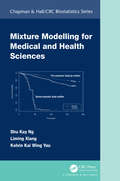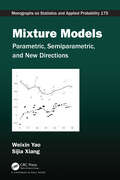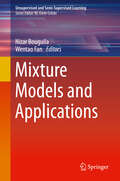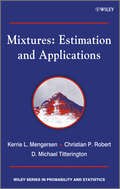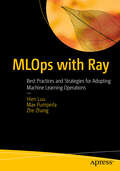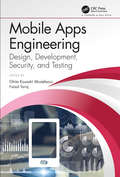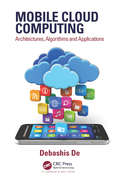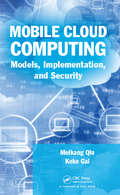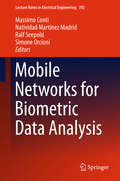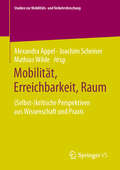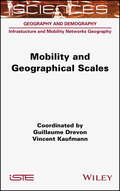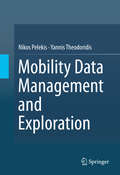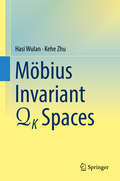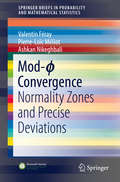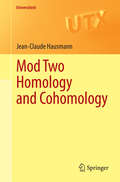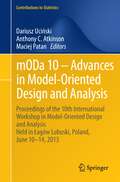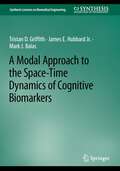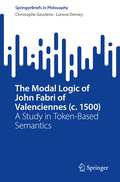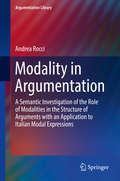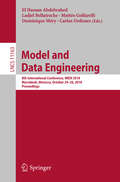- Table View
- List View
Mixture Modelling for Medical and Health Sciences (Chapman And Hall/crc Biostatistics Ser.)
by Shu-Kay NgMixture Modelling for Medical and Health Sciences provides a direct connection between theoretical developments in mixture modelling and their applications in real world problems. The book describes the development of the most important concepts through comprehensive analyses of real and practical examples taken from real-life research problems in
Mixture Models: Parametric, Semiparametric, and New Directions (ISSN)
by Weixin Yao Sijia XiangMixture models are a powerful tool for analyzing complex and heterogeneous datasets across many scientific fields, from finance to genomics. Mixture Models: Parametric, Semiparametric, and New Directions provides an up-to-date introduction to these models, their recent developments, and their implementation using R. It fills a gap in the literature by covering not only the basics of finite mixture models, but also recent developments such as semiparametric extensions, robust modeling, label switching, and high-dimensional modeling. Features Comprehensive overview of the methods and applications of mixture models Key topics including hypothesis testing, model selection, estimation methods, and Bayesian approaches Recent developments, such as semiparametric extensions, robust modeling, label switching, and high-dimensional modeling Examples and case studies from such fields as astronomy, biology, genomics, economics, finance, medicine, engineering, and sociology Integrated R code for many of the models, with code and data available in the R Package MixSemiRob Mixture Models: Parametric, Semiparametric, and New Directions is a valuable resource for researchers and postgraduate students from statistics, biostatistics, and other fields. It could be used as a textbook for a course on model-based clustering methods, and as a supplementary text for courses on data mining, semiparametric modeling, and high-dimensional data analysis.
Mixture Models and Applications (Unsupervised and Semi-Supervised Learning)
by Nizar Bouguila Wentao FanThis book focuses on recent advances, approaches, theories and applications related to mixture models. In particular, it presents recent unsupervised and semi-supervised frameworks that consider mixture models as their main tool. The chapters considers mixture models involving several interesting and challenging problems such as parameters estimation, model selection, feature selection, etc. The goal of this book is to summarize the recent advances and modern approaches related to these problems. Each contributor presents novel research, a practical study, or novel applications based on mixture models, or a survey of the literature.Reports advances on classic problems in mixture modeling such as parameter estimation, model selection, and feature selection;Present theoretical and practical developments in mixture-based modeling and their importance in different applications;Discusses perspectives and challenging future works related to mixture modeling.
Mixtures: Estimation And Applications (Wiley Series In Probability And Statistics Ser. #896)
by Christian Robert Mike Titterington Kerrie MengersenThis book uses the EM (expectation maximization) algorithm to simultaneously estimate the missing data and unknown parameter(s) associated with a data set. The parameters describe the component distributions of the mixture; the distributions may be continuous or discrete.The editors provide a complete account of the applications, mathematical structure and statistical analysis of finite mixture distributions along with MCMC computational methods, together with a range of detailed discussions covering the applications of the methods and features chapters from the leading experts on the subject. The applications are drawn from scientific discipline, including biostatistics, computer science, ecology and finance. This area of statistics is important to a range of disciplines, and its methodology attracts interest from researchers in the fields in which it can be applied.
MLOps with Ray: Best Practices and Strategies for Adopting Machine Learning Operations
by Max Pumperla Zhe Zhang Hien LuuUnderstand how to use MLOps as an engineering discipline to help with the challenges of bringing machine learning models to production quickly and consistently. This book will help companies worldwide to adopt and incorporate machine learning into their processes and products to improve their competitiveness. The book delves into this engineering discipline's aspects and components and explores best practices and case studies. Adopting MLOps requires a sound strategy, which the book's early chapters cover in detail. The book also discusses the infrastructure and best practices of Feature Engineering, Model Training, Model Serving, and Machine Learning Observability. Ray, the open source project that provides a unified framework and libraries to scale machine learning workload and the Python application, is introduced, and you will see how it fits into the MLOps technical stack. This book is intended for machine learning practitioners, such as machine learning engineers, and data scientists, who wish to help their company by adopting, building maps, and practicing MLOps. What You'll Learn Gain an understanding of the MLOps discipline Know the MLOps technical stack and its components Get familiar with the MLOps adoption strategy Understand feature engineering Who This Book Is For Machine learning practitioners, data scientists, and software engineers who are focusing on building machine learning systems and infrastructure to bring ML models to production
Mobile Apps Engineering: Design, Development, Security, and Testing
by Ghita Kouadri Mostefaoui and Faisal TariqThe objective of this edited book is to gather best practices in the development and management of mobile apps projects. Mobile Apps Engineering aims to provide software engineering lecturers, students and researchers of mobile computing a starting point for developing successful mobile apps. To achieve these objectives, the book’s contributors emphasize the essential concepts of the field, such as apps design, testing and security, with the intention of offering a compact, self-contained book which shall stimulate further research interest in the topic. The editors hope and believe that their efforts in bringing this book together can make mobile apps engineering an independent discipline inspired by traditional software engineering, but taking into account the new challenges posed by mobile computing.
Mobile Cloud Computing: Architectures, Algorithms and Applications
by Debashis DeMinimize Power Consumption and Enhance User ExperienceEssential for high-speed fifth-generation mobile networks, mobile cloud computing (MCC) integrates the power of cloud data centers with the portability of mobile computing devices. Mobile Cloud Computing: Architectures, Algorithms and Applications covers the latest technological and architectura
Mobile Cloud Computing: Models, Implementation, and Security
by Meikang Qiu Keke GaiMobile Cloud Computing: Models, Implementation, and Security provides a comprehensive introduction to mobile cloud computing, including key concepts, models, and relevant applications. The book focuses on novel and advanced algorithms, as well as mobile app development. <P><P>The book begins with an overview of mobile cloud computing concepts, models, and service deployments, as well as specific cloud service models. It continues with the basic mechanisms and principles of mobile computing, as well as virtualization techniques. The book also introduces mobile cloud computing architecture, design, key techniques, and challenges. <P><P>The second part of the book covers optimizations of data processing and storage in mobile clouds, including performance and green clouds. The crucial optimization algorithm in mobile cloud computing is also explored, along with big data and service computing. <P><P>Security issues in mobile cloud computing are covered in-depth, including a brief introduction to security and privacy issues and threats, as well as privacy protection techniques in mobile systems. The last part of the book features the integration of service-oriented architecture with mobile cloud computing. It discusses web service specifications related to implementations of mobile cloud computing. <P><P>The book not only presents critical concepts in mobile cloud systems, but also drives readers to deeper research, through open discussion questions. Practical case studies are also included. Suitable for graduate students and professionals, this book provides a detailed and timely overview of mobile cloud computing for a broad range of readers.
Mobile Networks for Biometric Data Analysis
by Massimo Conti Natividad Martínez Madrid Ralf Seepold Simone OrcioniThis book showcases new and innovative approaches to biometric data capture and analysis, focusing especially on those that are characterized by non-intrusiveness, reliable prediction algorithms, and high user acceptance. It comprises the peer-reviewed papers from the international workshop on the subject that was held in Ancona, Italy, in October 2014 and featured sessions on ICT for health care, biometric data in automotive and home applications, embedded systems for biometric data analysis, biometric data analysis: EMG and ECG, and ICT for gait analysis. The background to the book is the challenge posed by the prevention and treatment of common, widespread chronic diseases in modern, aging societies. Capture of biometric data is a cornerstone for any analysis and treatment strategy. The latest advances in sensor technology allow accurate data measurement in a non-intrusive way, and in many cases it is necessary to provide online monitoring and real-time data capturing to support a patient's prevention plans or to allow medical professionals to access the patient's current status. This book will be of value to all with an interest in this expanding field.
Mobilität, Erreichbarkeit, Raum: (Selbst-)kritische Perspektiven aus Wissenschaft und Praxis (Studien zur Mobilitäts- und Verkehrsforschung)
by Alexandra Appel Joachim Scheiner Mathias WildeDer Sammelband fasst wichtige Themen und Entwicklungen der Mobilitäts- und Verkehrsforschung der letzten Jahre zusammen. Die Beiträge gehen auf das Instrumentarium empirischer Forschung ein und erläutern deren Einsatzbereiche anhand konkreter Anwendungsfälle. Genauso zeigt der Sammelband jene Perspektiven auf, mit denen die Planungspraxis der (Um-)Gestaltung der Verkehrssysteme eine Form geben kann, um nachhaltigere Mobilität zu fördern. Damit richtet er sich sowohl an eine Leserschaft, die sich mit den wissenschaftlichen Grundlagen der Mobilitäts- und Verkehrsforschung befasst, als auch an eine Leserschaft, die an wissenschaftlich fundierten Maßnahmen zur nachhaltigen Umgestaltung der Verkehrssysteme interessiert ist.
Mobility and Geographical Scales
by Guillaume Drevon Vincent KaufmannThe concept of mobility has grown enormously over the last two decades. A large part of the social sciences has been interested in the different forms of mobility, from a wide variety of spatial and temporal scales. This book presents the different spatial and temporal scales of mobility and the way in which they form a system, by associating them with essential and original research objects. It provides an in-depth review of scientific knowledge, a perspective on major societal issues, analytical tools and a discussion on the main current academic debates. The authors highlight the need to take into account both the spatial and temporal scales of mobility in order to address contemporary environmental and societal issues. The book invites us to think about the entanglement of these different scales from the analysis of rhythms by founding a rhythmology of contemporary mobilities.
Mobility Data Management and Exploration
by Nikos Pelekis Yannis TheodoridisThis text integrates different mobility data handling processes, from database management to multi-dimensional analysis and mining, into a unified presentation driven by the spectrum of requirements raised by real-world applications. It presents a step-by-step methodology to understand and exploit mobility data: collecting and cleansing data, storage in Moving Object Database (MOD) engines, indexing, processing, analyzing and mining mobility data. Emerging issues, such as semantic and privacy-aware querying and mining as well as distributed data processing, are also covered. Theoretical presentation is smoothly interchanged with hands-on exercises and case studies involving an actual MOD engine. The authors are established experts who address both theoretical and practical dimensions of the field but also present valuable prototype software. The background context, clear explanations and sample exercises make this an ideal textbook for graduate students studying database management, data mining and geographic information systems.
Mobius Invariant QK Spaces
by Hasi Wulan Kehe ZhuThis monograph summarizes the recent major achievements in M#65533;bius invariant QK spaces. First introduced by Hasi Wulan and his collaborators, the theory of QK spaces has developed immensely in the last two decades, and the topics covered in this book will be helpful to graduate students and new researchers interested in the field. Featuring a wide range of subjects, including an overview of QK spaces, QK-Teichm#65533;ller spaces, K-Carleson measures and analysis of weight functions, this book serves as an important resource for analysts interested in this area of complex analysis. Notes, numerous exercises, and a comprehensive up-to-date bibliography provide an accessible entry to anyone with a standard graduate background in real and complex analysis.
Mod-ϕ Convergence
by Valentin Féray Pierre-Loïc Méliot Ashkan NikeghbaliThe canonical way to establish the central limit theorem for i. i. d. random variables is to use characteristic functions and L#65533;vy's continuity theorem. This monograph focuses on this characteristic function approach and presents a renormalization theory called mod-ϕ convergence. This type of convergence is a relatively new concept with many deep ramifications, and has not previously been published in a single accessible volume. The authors construct an extremely flexible framework using this concept in order to study limit theorems and large deviations for a number of probabilistic models related to classical probability, combinatorics, non-commutative random variables, as well as geometric and number-theoretical objects. Intended for researchers in probability theory, the text is carefully well-written and well-structured, containing a great amount of detail and interesting examples.
Mod Two Homology and Cohomology
by Jean-Claude HausmannCohomology and homology modulo 2 helps the reader grasp more readily the basics of a major tool in algebraic topology. Compared to a more general approach to (co)homology this refreshing approach has many pedagogical advantages: 1. It leads more quickly to the essentials of the subject, 2. An absence of signs and orientation considerations simplifies the theory, 3. Computations and advanced applications can be presented at an earlier stage, 4. Simple geometrical interpretations of (co)chains. Mod 2 (co)homology was developed in the first quarter of the twentieth century as an alternative to integral homology, before both became particular cases of (co)homology with arbitrary coefficients. The first chapters of this book may serve as a basis for a graduate-level introductory course to (co)homology. Simplicial and singular mod 2 (co)homology are introduced, with their products and Steenrod squares, as well as equivariant cohomology. Classical applications include Brouwer's fixed point theorem, Poincaré duality, Borsuk-Ulam theorem, Hopf invariant, Smith theory, Kervaire invariant, etc. The cohomology of flag manifolds is treated in detail (without spectral sequences), including the relationship between Stiefel-Whitney classes and Schubert calculus. More recent developments are also covered, including topological complexity, face spaces, equivariant Morse theory, conjugation spaces, polygon spaces, amongst others. Each chapter ends with exercises, with some hints and answers at the end of the book.
mODa 10 – Advances in Model-Oriented Design and Analysis
by Maciej Patan Dariusz Ucinski Anthony C. AtkinsonThis book collects the proceedings of the 10th Workshop on Model-Oriented Design and Analysis (mODa). A model-oriented view on the design of experiments, which is the unifying theme of all mODa meetings, assumes some knowledge of the form of the data-generating process and naturally leads to the so-called optimum experimental design. Its theory and practice have since become important in many scientific and technological fields, ranging from optimal designs for dynamic models in pharmacological research, to designs for industrial experimentation, to designs for simulation experiments in environmental risk management, to name but a few. The methodology has become even more important in recent years because of the increased speed of scientific developments, the complexity of the systems currently under investigation and the mounting pressure on businesses, industries and scientific researchers to reduce product and process development times. This increased competition requires ever increasing efficiency in experimentation, thus necessitating new statistical designs. This book presents a rich collection of carefully selected contributions ranging from statistical methodology to emerging applications. It primarily aims to provide an overview of recent advances and challenges in the field, especially in the context of new formulations, methods and state-of-the-art algorithms. The topics included in this volume will be of interest to all scientists and engineers and statisticians who conduct experiments.
A Modal Approach to the Space-Time Dynamics of Cognitive Biomarkers (Synthesis Lectures on Biomedical Engineering)
by Tristan D. Griffith James E. Hubbard Jr. Mark J. BalasThis book develops and details a rigorous, canonical modeling approach for analyzing spatio-temporal brain wave dynamics. The nonlinear, nonstationary behavior of brain wave measures and general uncertainty associated with the brain makes it difficult to apply modern system identification techniques to such systems. While there is a substantial amount of literature on the use of stationary analyses for brain waves, relatively less work has considered real-time estimation and imaging of brain waves from noninvasive measurements. This book addresses the issue of modeling and imaging brain waves and biomarkers generally, treating the nonlinear and nonstationary dynamics in near real-time. Using a modal state-space formulation leads to intuitive, physically significant models which are used for analysis and diagnosis.A Modal Approach to the Space-Time Dynamics of Cognitive Biomarkers provides a much-needed reference for practicing researchers in biomarker modeling leveraging the lens of engineering dynamics.
Modal Interval Analysis
by Miguel A. Sainz Joaquim Armengol Remei Calm Pau Herrero Lambert Jorba Josep VehiThis book presents an innovative new approach to interval analysis. Modal Interval Analysis (MIA) is an attempt to go beyond the limitations of classic intervals in terms of their structural, algebraic and logical features. The starting point of MIA is quite simple: It consists in defining a modal interval that attaches a quantifier to a classical interval and in introducing the basic relation of inclusion between modal intervals through the inclusion of the sets of predicates they accept. This modal approach introduces interval extensions of the real continuous functions, identifies equivalences between logical formulas and interval inclusions, and provides the semantic theorems that justify these equivalences, along with guidelines for arriving at these inclusions. Applications of these equivalences in different areas illustrate the obtained results. The book also presents a new interval object: marks, which aspire to be a new form of numerical treatment of errors in measurements and computations.
Modal Logic
by Patrick Blackburn Maarten De Rijke Yde VenemaThis modern, advanced textbook reviews modal logic, a field which caught the attention of computer scientists in the late 1970's. The development is mathematical; prior acquaintance with first-order logic and its semantics is assumed, and familiarity with the basic mathematical notions of set theory is required. The authors focus on the use of modal languages as tools to analyze the properties of relational structures, including their algorithmic and algebraic aspects. Applications to issues in logic and computer science such as completeness, computability and complexity are considered.
Modal Logic for Philosophers
by James W. GarsonDesigned for use by philosophy students, this 2006 book provides an accessible, yet technically sound treatment of modal logic and its philosophical applications. Every effort has been made to simplify the presentation by using diagrams in place of more complex mathematical apparatus. These and other innovations provide philosophers with easy access to a rich variety of topics in modal logic, including a full coverage of quantified modal logic, non-rigid designators, definite descriptions, and the de-re de-dictio distinction. Discussion of philosophical issues concerning the development of modal logic is woven into the text. The book uses natural deduction systems and also includes a diagram technique that extends the method of truth trees to modal logic. This feature provides a foundation for a novel method for showing completeness, one that is easy to extend to systems that include quantifiers.
The Modal Logic of John Fabri of Valenciennes: A Study in Token-Based Semantics (SpringerBriefs in Philosophy)
by Christophe Geudens Lorenz DemeyThe first book-length study to address issues in modal logic at the eve of the Renaissance, this monograph provides important new insights into the way the debates on modal logic during the post-medieval period tied in with the so-called Wegestreit, the divide between the via antiqua and via moderna that dominated the discourse on logic during the 15th and early 16th centuries. The focus of the book is on the logic and philosophy of language of John Fabri of Valenciennes (fl. c. 1500), one of the last exponents of the terminist approach to logic that was bitterly criticized by the humanist movement. By means of a careful reconstruction of Fabri’s text, the book argues that Fabri's modal logic ultimately goes back to the work of John Buridan, and represents the same approach to the topic as the modal logics that were developed by adherents of the via moderna in Paris. This has significant implications for the historiography of post-medieval philosophy. Fabri was active in Louvain, which until the late 16th century was the most important intellectual center in the Low Countries. According to a long-standing tradition in the scholarship, Louvain was one of the few bulwarks of via antiqua logic on the map of post-medieval Europe. The book argues that this thesis is at least in part a scholarly fiction, and thus in need of revision. By shedding light on an author whose thought has thus far remained entirely unstudied, it also constitutes a valuable step towards a history of philosophy without any gaps. The book is aimed at graduate students and researchers in the history of logic and philosophy, but will also be of interest to intellectual historians, historians of ideas, and to any contemporary modal logician who is interested in the historical roots of their discipline.
Modality and Propositional Attitudes
by Michael HegartyThis book shows that the semantic analysis of modal notions of possibility and necessity can be used to enhance our understanding of the interpretation of reports of belief or emotional state. It introduces intuitive notation and terminology to express ideas in modern theories of modal interpretation that are normally represented in complex logical formulas, effectively updates the 1960s-era link between possible worlds and the semantics of propositional attitude ascriptions, and reconciles two disparate views of the role of events in semantic interpretation, that of Donald Davidson and that of David Lewis. It reduces a host of variable behaviors of propositional attitude ascription to an intuitive and precise distinction between ascriptions that merely express a commitment to propositional content versus ones that attribute a mental state to the holder of the propositional attitude. This leads to an explanation of the nature and effects of the language disorder of fluent aphasia.
Modality in Argumentation
by Andrea RocciThis book addresses two related questions that have first arisen in Toulmin's seminal book on the uses of argument. The first question is the one of the relationship between the semantic analysis of modality and the structure of arguments. The second question is the one of the distinctive place, or role, of modality in the fundamental structure of arguments. These two questions concern how modality, as a semantic category, relates to the fundamental structure of arguments. The book addresses modality and argumentation also according to another perspective by looking at how different linguistic modal expressions may be taken as argumentative indicators. It explores the role of modal expressions as argumentative indicators by using the Italian modal system as a case study. At the same time, it uses predictions/forecasts in the business-financial daily press to investigate the relation between modality and the context of argumentation.
Model and Data Engineering: 8th International Conference, MEDI 2018, Marrakesh, Morocco, October 24–26, 2018, Proceedings (Lecture Notes in Computer Science #11163)
by El Hassan Abdelwahed Ladjel Bellatreche Mattéo Golfarelli Dominique Méry Carlos OrdonezThis book constitutes the refereed proceedings of the 8h International Conference on Model and Data Engineering, MEDI 2018, held in Marrakesh, Morocco, in October 2018.The 23 full papers and 4 short papers presented together with 2 invited talks were carefully reviewed and selected from 86 submissions. The papers covered the recent and relevant topics in the areas of databases; ontology and model-driven engineering; data fusion, classsification and learning; communication and information technologies; safety and security; algorithms and text processing; and specification, verification and validation.
Model and Data Engineering: 13th International Conference, MEDI 2024, Naples, Italy, November 18–20, 2024, Proceedings (Lecture Notes in Computer Science #15590)
by Carlos Ordonez Giancarlo Sperlì Elio Masciari Ladjel BellatrecheThis book constitutes the refereed proceedings of the 13th International Conference onModel and Data Engineering, MEDI 2024, held in Naples, Italy, during November 18–20, 2024. The 7 full papers and 11 short papers were carefully peer reviewed and selected from 45 submissions.They were organized in topical sections as follows: AI-Enabled Systems; Security and Privacy; Query Processing; Prediction; Conceptual Issues; and Applications.
